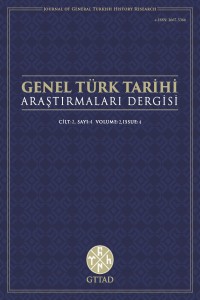Abstract
There are three different opinions about the origin of
Old Turkic rune alphabet. They are Aramey, Sogdian and it's an own Central
asian nomads creation. Due to the results of last years archeological
excavations carried out on the territory of a place of residence of ancient
nomads (modern north places –north of Huang-he, Mongolian territory) and
preserved monuments, official Chinese sources (V B.C.- VI A.D. ) concerning to
shuji writing, we have got the possibility to pay attention to the third
opinion about the origin of writing. The author analyzed every petroglyph or
tanba preserved in Central and Middle Asia and every writing of different
periods. The author conducted an analysis of these historical values and proved
it was the own creation nomadic people.
References
- 1. Batsaıhan Z. Sıunnugıın «kemu» bıchıg, tuunıı holbogdol. // SA.T.XIV. UB.1994.108-115 p. 2. Bıchurın N.Ia. (Iaknıf). Sobranıe svedenıı o narodah, obıtavshıh v Sredneı Azıı v drevnıe vremena. М-Л.1950.т.І. 3. Damdınsúren A. Arheologıın shınjılgeegeer oldson hunnugıın bıchgıın dursgaluud. // SA.T.V.fasc.1-13. UB.1972.99-111 тал. 4. Huang bo rong.Xian dai han yu, Beijing.2004.163 5. Istrin V.А. Vozniknovenie i razvitie pis’ma. М.1965. 6. Jungo tarıhnamalaryndaǵy qazaqqa qatysty derekter. t.II. Pekın.2003. 7. Kyzlasov I.L. Runıcheskıe pısmennostı Evrazııskıh stepeı. М.1994. 8. Lıvshıts V.A. O proıshojdenıı drevneturkskoı runıcheskoı pısmennostı // Arheologıcheskıe ıssledovanııa drevnogo ı srednevekovogo Kazahstana.А-А.1980.с.3-13. 9. Mongolyn arheologı. UB.2002. 10. Nemeth J. Die inscriften des Schatzcs von Nage-Szent-Miklos. Leipzig.1932. 11. Novogradova E.A. V strane petroglıfov ı edelveısov. М.1982. 12. Novogradova E.A. Arashan-had – drevneıshıı pamıatnık ızobrazıtelnogo ıskusstva Vostochnyı Mongolıı. // Istorııa ı kultury Tsentralnoı Azıı. М.1983.p.303-310. 13. Okladnıkov A.P. Tsentralnoazıatskıı ochag pervobytnogo ıskusstva. Novosıbırsk.1972. 14. Qazaq tіlі grammatıkasy. А.2002. 15. Sartqoja Q. Baıyrgy turіk jazuynyn genezısі. Astana. 2003. 16. Sartqojauly Q. Altaıdan tabylǵan ejelgі túrіk jazuu // Uluslararasi Turkoloji kongresi. Turkstan.2009. c.137-145. 17. Sherbak A.M. Turkskaıa runıka. St-B.2001. 18. Sherbak A.M. Neskolko slov o prıemah chtenııa runıcheskıh nadpıseı, naıdennyh na Donu // СА. 1954.p.269-282. 19. Sherbak A.M. O runıcheskoı pısmennostı v yugo-vostochnoı Evrope // СТ. 1971.№4.p.76-82. 20. Zhonggou gudai huo bi fa zhan shi, Beijing. 1958, 71-72
Abstract
There are three different opinions about the origin of old turkic rune alphabet. They are Aramey, Sogdian and it's an own Central asian nomads creation. Due to the results of last years archeological excavations carried out on the territory of a place of residence of ancient nomads (modern north places –north of Huang-he, Mongolian territory) and preserved monuments, official Chinese sources (V B.C.- VI A.D. ) concerning to shuji writing we have got the possibility to pay attention to the third opinion about the origin of writing. The author analyzed every petroglyth or tanba preserved in Central and Middle Asia and every writing of different periods. The author conducted an analysis of these historical values and proved it was the own creation nomadic people.
Keywords
References
- 1. Batsaıhan Z. Sıunnugıın «kemu» bıchıg, tuunıı holbogdol. // SA.T.XIV. UB.1994.108-115 p. 2. Bıchurın N.Ia. (Iaknıf). Sobranıe svedenıı o narodah, obıtavshıh v Sredneı Azıı v drevnıe vremena. М-Л.1950.т.І. 3. Damdınsúren A. Arheologıın shınjılgeegeer oldson hunnugıın bıchgıın dursgaluud. // SA.T.V.fasc.1-13. UB.1972.99-111 тал. 4. Huang bo rong.Xian dai han yu, Beijing.2004.163 5. Istrin V.А. Vozniknovenie i razvitie pis’ma. М.1965. 6. Jungo tarıhnamalaryndaǵy qazaqqa qatysty derekter. t.II. Pekın.2003. 7. Kyzlasov I.L. Runıcheskıe pısmennostı Evrazııskıh stepeı. М.1994. 8. Lıvshıts V.A. O proıshojdenıı drevneturkskoı runıcheskoı pısmennostı // Arheologıcheskıe ıssledovanııa drevnogo ı srednevekovogo Kazahstana.А-А.1980.с.3-13. 9. Mongolyn arheologı. UB.2002. 10. Nemeth J. Die inscriften des Schatzcs von Nage-Szent-Miklos. Leipzig.1932. 11. Novogradova E.A. V strane petroglıfov ı edelveısov. М.1982. 12. Novogradova E.A. Arashan-had – drevneıshıı pamıatnık ızobrazıtelnogo ıskusstva Vostochnyı Mongolıı. // Istorııa ı kultury Tsentralnoı Azıı. М.1983.p.303-310. 13. Okladnıkov A.P. Tsentralnoazıatskıı ochag pervobytnogo ıskusstva. Novosıbırsk.1972. 14. Qazaq tіlі grammatıkasy. А.2002. 15. Sartqoja Q. Baıyrgy turіk jazuynyn genezısі. Astana. 2003. 16. Sartqojauly Q. Altaıdan tabylǵan ejelgі túrіk jazuu // Uluslararasi Turkoloji kongresi. Turkstan.2009. c.137-145. 17. Sherbak A.M. Turkskaıa runıka. St-B.2001. 18. Sherbak A.M. Neskolko slov o prıemah chtenııa runıcheskıh nadpıseı, naıdennyh na Donu // СА. 1954.p.269-282. 19. Sherbak A.M. O runıcheskoı pısmennostı v yugo-vostochnoı Evrope // СТ. 1971.№4.p.76-82. 20. Zhonggou gudai huo bi fa zhan shi, Beijing. 1958, 71-72
Details
| Primary Language | English |
|---|---|
| Journal Section | Articles |
| Authors | |
| Publication Date | July 20, 2020 |
| Submission Date | April 2, 2020 |
| Published in Issue | Year 2020 Volume: 2 Issue: 4 |


